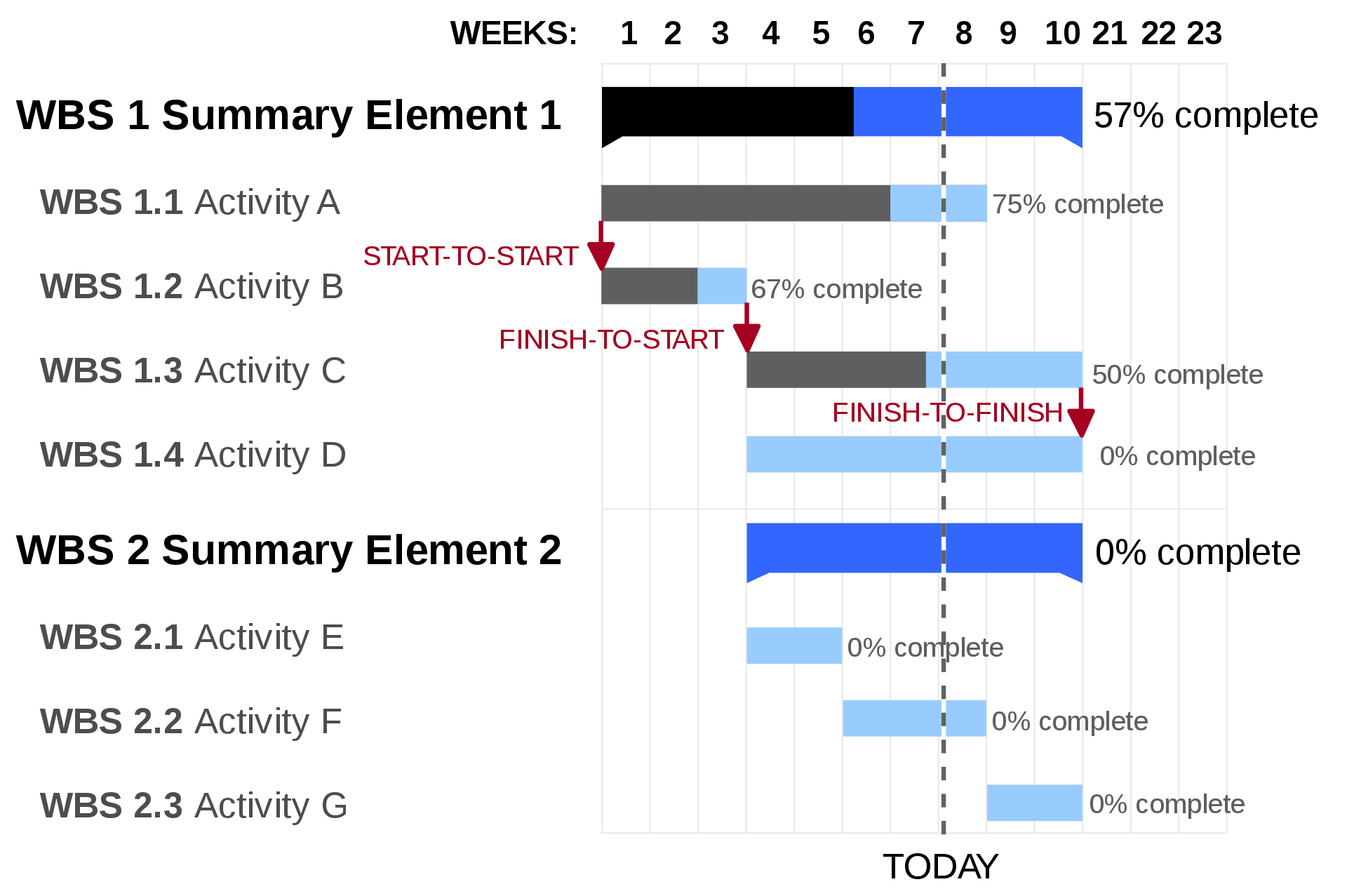12 Gantt Charts
Content for this chapter was adapted from Wikipedia, the free encyclopedia

Introduction
A Gantt chart is a type of bar chart that illustrates a project schedule. This chart lists the tasks to be performed on the vertical axis, and time intervals on the horizontal axis.The width of the horizontal bars in the graph shows the duration of each activity. Gantt charts illustrate the start and finish dates of the terminal elements and summary elements of a project. Terminal elements and summary elements constitute the work breakdown structure of the project. Modern Gantt charts also show the dependency relationships between activities. Gantt charts can be used to show current schedule status using percent-complete shadings and a vertical “TODAY” line as shown in the graphic above. There is not one correct way to create a Gantt chart, but the chart should include clear dates and separate major milestones in the project. Gantt charts represent a commitment to a timeline for the project by a team. This also means that creating a Gantt chart involves some estimation about how long each project will take and create a structure for the team to follow in order to reach their goals. Gantt charts are usually created initially using an early start time approach, where each task is scheduled to start immediately when its prerequisites are complete. This method maximizes the float time available for all tasks. Gantt charts are “one of the most widely used management tools for project scheduling and control” In the following table there are seven tasks, labeled a through g. Some tasks can be done concurrently (a and b) while others cannot be done until their predecessor task is complete (c and d cannot begin until a is complete; a dependency relationship). Additionally, each task has three time estimates: the optimistic time estimate (O), the most likely or normal time estimate (M), and the pessimistic time estimate (P). The expected time (TE) is estimated.
| Activity | Predecessor | Time estimates | Expected time (TE) | ||
|---|---|---|---|---|---|
| Opt. (O) | Normal (M) | Pess. (P) | |||
| a | — | 2 | 4 | 6 | 4.00 |
| b | — | 3 | 5 | 9 | 5.33 |
| c | a | 4 | 5 | 7 | 5.17 |
| d | a | 4 | 6 | 10 | 6.33 |
| e | b, c | 4 | 5 | 7 | 5.17 |
| f | d | 3 | 4 | 8 | 4.50 |
| g | e | 3 | 5 | 8 | 5.17 |
Once estimates and dependencies are understood, a team can draw a Gantt chart or a network diagram. Below are several examples of Gantt Charts.
A Gantt chart created using Microsoft Project (MSP). Note (1) the dependency relationships are in red, (2) the float time is represented by black lines connected to non-critical activities, (3) since Saturday and Sunday are not work days and are thus excluded from the schedule, some bars on the Gantt chart are longer if they cut through a weekend.
See this tutorial from Microsoft Office for a step-by-step guide to creating a Gantt chart in excel. If you’re reading the text version of this book, visit https://support.microsoft.com and search for Gantt Chart. Below are some other examples of Gantt charts. Use your favorite search engine to find more Gantt Chart examples and online tools to build Gantt charts.


Using Gantt Charts – Exelon Development (a Tech Company):
According to Matt Heusser (2020), Gantt charts help a team to sort out just how multiple units can be shuffled without missing deadlines. Gantt charts could be useful for the company to forecast. A good Gantt chart will provide a coherent strategy, giving you a roadmap of the project from beginning to end in one visual snapshot.
A Gantt chart is essentially a tool for project management. According to an article on Asanda.com (a company specializing in project management software), the Gantt Chart typically includes the following pieces of information:
- When the project is due
- When to start and finish each task
- How long each task takes
- Who is responsible for each task
- Which tasks depend on others
- How each task is categorized or grouped
References
- Asanda.com (n.d.) New to gantt charts? Start here. Retrieved from https://asana.com/resources/gantt-chart-basics
- Clark, W.(1922). The Gantt chart: A working tool of management. Ronald Press.
- Flouris, T. G., & Lock, D., (2012). Managing aviation projects from concept to completion. Ashgate publishing limited.
- Gantt, H. L. (1910). Work, wages and profit. Engineering magazine. Hive publishing company.
- Heusser, M. (2020, March, 17) What’s the purpose of a Gantt chart for large scale projects? https://searchsoftwarequality.techtarget.com/tip/whats-the-purpose-of-a-gantt-chart-for-large-scale-projects
- Klein, E. (1999). Scheduling of resource-constrained projects. Operations research/computer science interfaces series. Springer.
- Marsh, E. R. (1974). The harmonogram of Karol Adamiecki. Academy of management proceedings, 32. https://doi.org/10.5465/ambpp.1974.17530521
- Morris, P.W. G. (1997). The management of projects. Thomas Telford.
- Richman, l. (2002). Project management step-by-step. Amacom.
- Selig, G. J. (2008). Implementing IT governance: a practical guide to global best practices in it management. Van haren publishing.
- Weaver, P. (2017). A brief history of scheduling: Back to the future. PM World Journal. 3(8).
- Wilson, J. M. (2003). Gantt charts: A centenary appreciation. European Journal of Operational Research, 149(2), 430–437 https://doi.org/10.1016/s0377-2217(02)00769-5
a type of bar chart that illustrates a project schedule
Links among major components of a project (e.g., to build a house laying a foundation is a dependency for putting up walls).
an action or event marking a significant change or stage in development.
The amount of time that a task in a project network can be delayed without causing a delay to: subsequent tasks ("free float") or project completion date ("total float").


